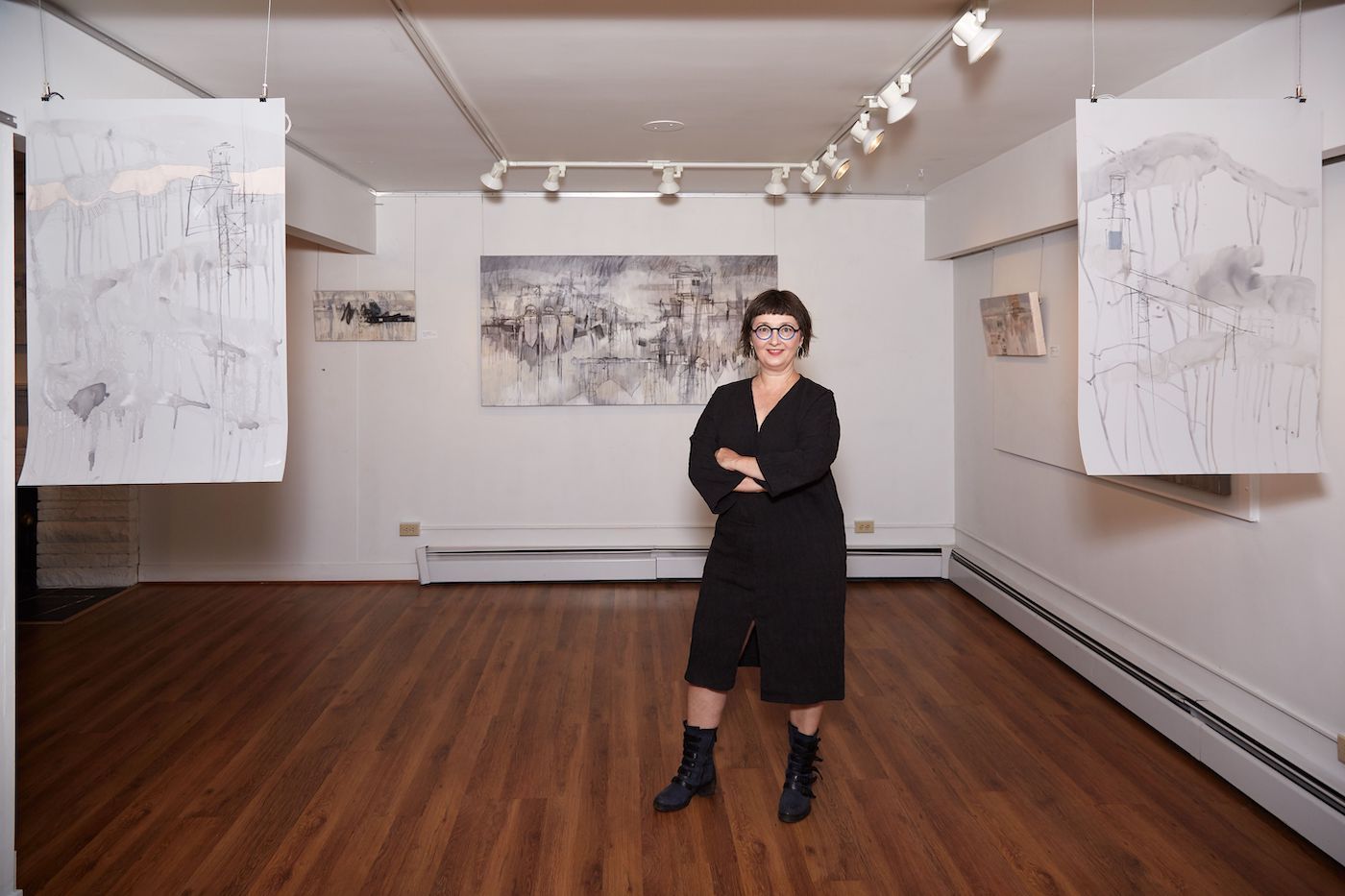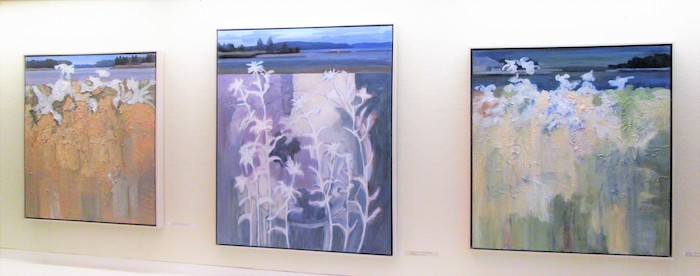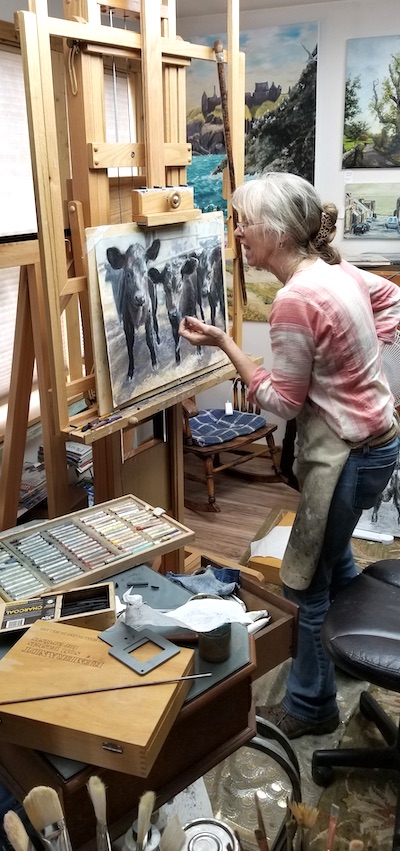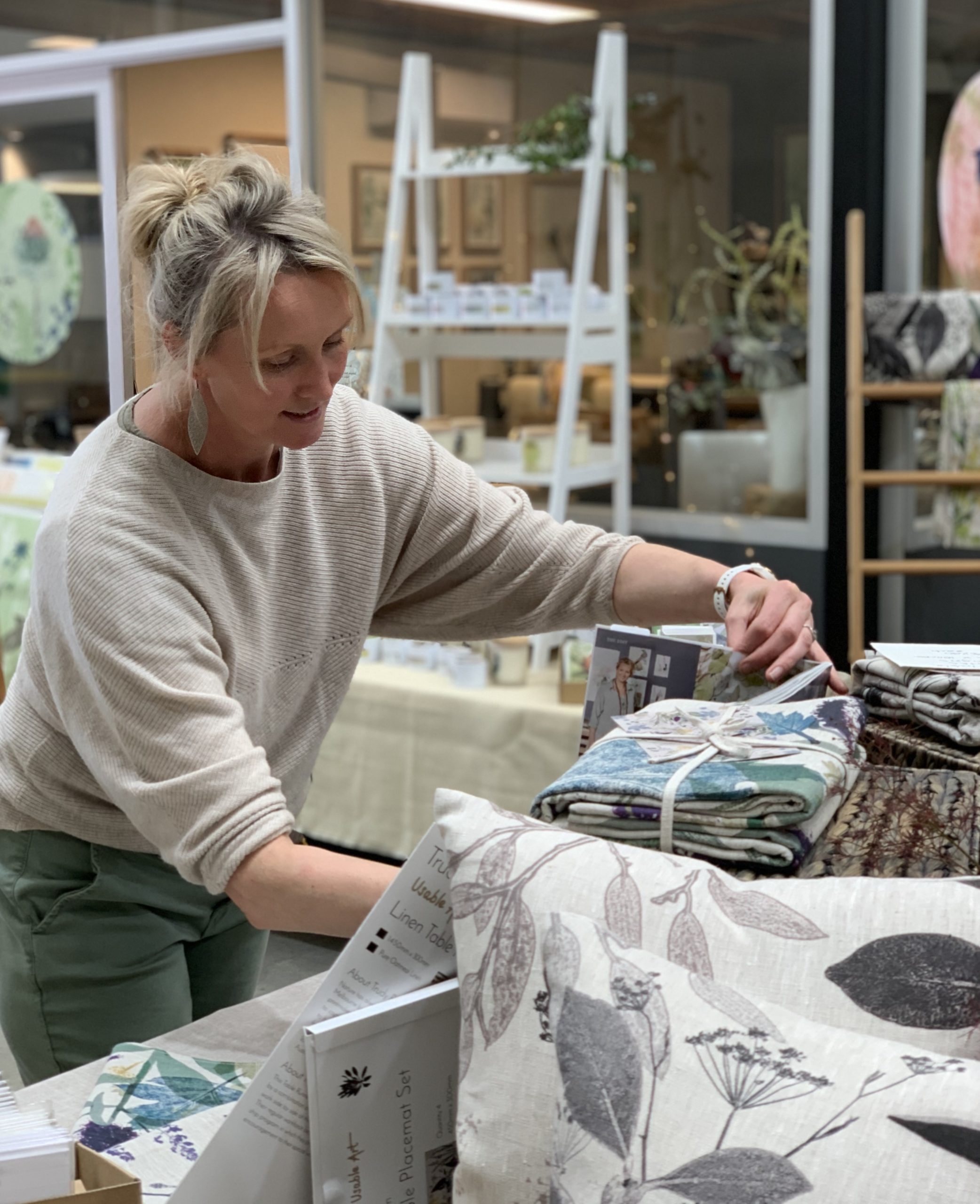Making a Living as an Artist: Considerations for Going Full-Time
Making a living as an artist isn’t for everyone.
Alyson Stanfield
Something (not necessarily good) happens internally when you begin to think of your art as a means to pay the bills rather than an enjoyable activity.
It takes more than passion to be a full-time artist. When you’re putting your work out there for all to see—AND asking for money for it—you feel exposed. Vulnerable.
Not everyone can handle this. Not everyone wants to handle it. Not everyone should handle it.

It’s also a lot to ask of your art to make money for you. You might be tempted to make work for the market, which, IMHO is driving the nail into creativity’s coffin. Don’t. Do. That.
But when things are looking up for you and sales and opportunities are rolling in, you can begin to think about making a living with your art.
You’ll never know if it’s the right decision to take the leap toward making a living as an artist. There are no guarantees in life or business. You have to trust that it’s right for you and have faith that you will do what is required to make it work.
You won’t wait for the perfect time to make this big move because you realize there is no such thing. If you don’t take action now, you’ll regret it later. If you don’t take action now, you won’t be any closer to the dreams you have for your life.
Once the decision is made … once you decide to move forward with a full-blown art business … I encourage you to embrace your ambitions. Own them.
Don’t be embarrassed to admit that you want more for yourself and for your art. Remember that your business and career are choices you have made to be in charge of your life.
There is no reason to postpone your plan. NOW is exactly the right time to begin building your art business.
In this article, I’m going to walk you through considerations for turning your hobby or passion into a full-time art business. Let’s start with the most important.
Your first step is to make a cohesive body of work.
Too many artists are marketing their art prematurely. It’s so easy to share something on social media, but much harder to do the difficult work in the studio. And you absolutely must be devoted to the latter.
When you share your art prematurely, you haven’t taken the time to develop as an artist. If this is you, take a deep breath and remember that, above all, you must make art in order to call yourself an artist. Your studio practice is your #1 priority. Always.
If you’re not making art, you have nothing to share with the world. If you have no art, you have nothing to sell. Without the art, you are not an artist.

The definition of a body of work varies from artist to artist. For one artist, a body of work might be defined by size. For another artist, it might be color, media, or subject matter.
I can’t give you a precise number of pieces that are within a body of work. I can’t even give you a number on average.
The emerging artist is most concerned with producing a body of work defined by a recognizable style. This means that the emerging artist is looking for quantity as well as quality. A few pieces by a new artist won’t convince the art establishment of your capabilities. You need enough for a solid exhibition.
You’ll be rewarded when you focus your creative energy on creating a body of work that you’re proud of. Only then will you have the confidence to put it out into the world. That brings me to my next point.
Your commitment will see you through the rough times.

Jan Clizer painting in her studio, working on a color study for the final painting in a series of commissions for Gamble Sands Golf Resort in Brewster, WA. Photo by Jessica Mackenzie.
There’s a romantic vision of living the artist’s life, toiling in the studio day after day. Covered with paint, glue, clay, or dust. Forgetting to eat because you were in flow. Staying up all hours because you were inspired. Committing to the wine, cheese, and crackers diet that comes with the circuit of art openings.
And then there is the reality—the part that just might suck. Working on deadlines. Sending another email invitation. Dealing with difficult personalities. Moving past the rejections.
The romance and the reality, and everything that comes with them, are expected when you’re trying to make a living as an artist. You must be committed to this extraordinary life that few are fortunate enough to experience.
How do you prepare? I wish I had wise words, but my modus operandi is to take off running and figure out the path along the way.
If someone told me that I had to have a written business plan before starting my business, I’d still be an unhappy museum employee.
You aren’t going to love everything about running a business. Get used to it. You have to keep your eye on the end goal. Find a way to be happy 90% of the time and you’ll excel. Which brings me to …
The professional artist is constantly seeking improvement.
When you are clear about your commitment, failure isn’t an option. You will keep going no matter what. So watch it with the self-talk.
Be aware of believing in self-imposed limitations. I’ve heard variations of the following from too many artists to count.
I am not a salesperson.
I am not outgoing.
I am terrible at marketing.
I am bad at following up.
These are self-fulfilling prophecies. You can’t say, “I’m terrible at marketing” without being terrible at marketing.
Instead, opt for a growth mindset, which simply means that you’re not limiting yourself with negative believes. You’re on the improvement train.
I get a kick out of sharing my art with others.
I enjoy meeting interesting people.
I follow up on opportunities that are important to me.
Being with like-minded professional artists is essential for your growth.
I’ve been working with artists long enough to know that those who are part of a vibrant artist community will advance faster than artists who aren’t. In the right artist group, you will hear about opportunities you never knew existed, learn skills, pick up the latest tips and tricks, and gain confidence in your abilities as a businessperson.
Finding your people is one of the most impactful steps you can take for business growth, which is why one of my first recommendations to beginner artists is that they become involved in an artist group or organization, even if they have to start it themselves.
I also know that it’s easy to get stuck in the wrong group of artists–artists who don’t have similar goals to yours. This is a terrible waste of your time and can only end in frustration. Take the time to find a good fit for you and don’t discount online communities like my Art Biz Connection.

Aim for profitability when you want to make a living as an artist.

As a full-time artist, you need to figure out where the money is going to come from.
What, exactly, will you sell? Can you produce enough work to have a solo exhibition or build an impressive website? Can you make enough art that, if it sells, you will reach your income goal? Do the math.
Staring down numbers on spreadsheets isn’t for the faint of heart. It takes real commitment to understand how you will make enough money to pay the bills, save, and invest.
Most artists need more than one income source. There’s no shame in teaching, consulting, or selling products.
You must think like an entrepreneur if you want to make a profit. While it’s tempting to offer a bunch of low-priced items for sale, it doesn’t always make sense. Again, do the math.
You’ll discover that it takes just as much marketing effort to sell a $150 reproduction as it does to sell a $1500 original. Where will you spend your energy?
Seek increasingly prestigious (and lucrative) venues for showing and selling your art.
Promoting and selling your art online is fine, but exhibiting live is critical for your professional growth. Nothing can replace the viewer’s experience of seeing your art in person, and nothing can replace your satisfaction from bringing the work together in a single venue.
As you begin to concentrate more on reliable income, you need to be sure your venues can sell at the price point you want.
When you have dreams and goals, it helps to remember that your art career is a journey with phases. The steps you take in the beginning are different from those when you are more established.

Most of my students and clients start out with a keen desire to gain gallery representation. Some want representation because they believe galleries can sell the work better, but most seek representation because of the validation that comes with a gallery wanting to show your work.
If this is you, please educate yourself before starting on this path. A lot of work goes into a career and a lot of dues must be paid before an artist earns gallery representation.
Above all, make sure you are ready for a gallery.
The good news is that commercial galleries are not the only place for showing and selling your art. In fact, a very small percentage of artists will ever show their art in fine galleries.
There are so many ways to show and sell your art today.
Depending on the type of work you make, you might consider working with art consultants, interior designers, or entering public art competitions. You might also enjoy accepting commissions from clients who want a custom piece of art for a specific spot in their home or memory.
The possibilities are limited only by your imagination and, perhaps, your ego.
Polish your time management skills.
Many artists bristle at the thought of being confined by a clock or calendar. After all, freedom is, presumably, one reason you have chosen the artist’s life.
You can be as free as you want in your studio, but once you decide you want to be part of the art game … once you decide that you want to make a living as an artist … you and you alone are responsible for your success.
People depend on you to follow through and meet your deadlines.
As an artist, you’re blessed with an abundance of ideas. But that blessing can sometimes feel like a burden.
How do you know which ideas are right for you at this time? And which are the best use of your time?

You must enact boundaries around your time and energy. Even more importantly, you must adhere to those boundaries. If you don’t respect them, nobody else will. More demands will come as your success increases. You might as well put these limitations in place from the get-go.
In addition to setting boundaries with your time and with other people, you need to learn to manage yourself. I know I encouraged you to polish your time-management skills, but, in truth, you can’t manage time. You can only manage yourself, so let’s call it what it is and hone your self-management skills.
As you become more successful, you’ll be offered more opportunities. Some of these will be a perfect fit and others not so much.
You’ll also be asked to serve in leadership roles. Again, some may be like Little Red Riding Hood’s third attempts, Just right!, and others more like time sucks.
You can’t say Yes to everything and have a successful art career. You have to learn to say No without feeling guilty about it. This is some tough self-love, and absolutely necessary when you are the CEO of a profitable art business. (Or when you want to be the CEO of a profitable art business.)
When you say Yes to everything, you end up saying No to your most important goals. Productivity isn’t about doing more. It’s about prioritizing the opportunities and working on your highest value tasks and projects. Focusing on what’s most important sends the message to others to take you seriously.
Remember, you are depending on you to make a living. Don’t let yourself down.
A wise use of your time is to ..
Invest energy into business planning.
It’s easier than ever to find yourself caught up in responding to emails, scrolling through social media posts, and clicking on random links that have nothing to do with how you want to show up in the world. Before you know it, the days have flown by and the list of things you want to accomplish isn’t shrinking.
You must spend a good amount of time working on your business rather than staying busy in your business. Busy does not equal productive. I’m sure I don’t have to tell you that.
We’ve already established that, as a creative soul, you have tons of ideas. When all of those ideas are floating around your head they begin to bump into one another. Each one has a voice: Try me! Work on me! Pssst … over here! Why are you ignoring me? They can be pesky, demanding, and loud. You either begin to feel overwhelmed by their insistence or ignore them and do nothing.
The only solution is to create a structure for your ideas. Get them out of your head and into a plan before they drive you nuts. And before they disappear forever.
Make a plan for your exhibition.
Make a plan for having a sale.
Make a plan for turning your collectors into a sales force.
There’s a plan for everything!
Find a way to enjoy marketing.
Making a living as an artist doesn’t mean that you’re able to make art all of the time. Au contraire! Earlier in this article I broke the news that you’re going to have to face some tasks you don’t enjoy doing.
The more successful you are, the more time you’ll be spending on the business side rather than in the studio. This will include coordinating calendars, organizing shipments, welcoming studio visits from curators, and meeting deadlines. It might also mean managing team members. It most certainly means more marketing.
Marketing is everything you do to gain recognition and sell your art. It’s something you will need to be consistent with because inconsistent marketing leads to erratic results.
You’ll never hear me refer to your marketing as a campaign because that implies there is a beginning and an end. You can’t be reaching out and looking for connections only when you feel like it.
Some of your marketing will be in person. You will be expected to show up for your galleries and for other artists because a huge part of the life of a successful artist is being seen.
Because you will have so many responsibilities and opportunities calling for your attention, it’s more important than ever to create lasting habits and routines. Consider a weekly self-promotion routine to keep you on track.
There are all kinds of ways you can spend your time, energy and money. As you focus on a profitable art business, you have to be selective. Where is it most likely you’ll find your audience?
You can do this.
What I’ve shared above is a laundry list of considerations for making a living as an artist. If I had to boil it down to 1 thing, I’d encourage you to focus on …
Commitment
When the commitment is there, you can figure out the rest. When you’re committed to your art and your goal, nothing will stand in your way. You will persevere.
Yes, you have plenty of work ahead of you, but what’s the alternative? To not go after your dream? To be complacent with the status quo? To live a life of regret?
None of these are acceptable.
Your art is not just how you express yourself. It’s how you communicate with the world. When you keep it to yourself, you are not doing justice to the art. Nor will you ever be fulfilled.




